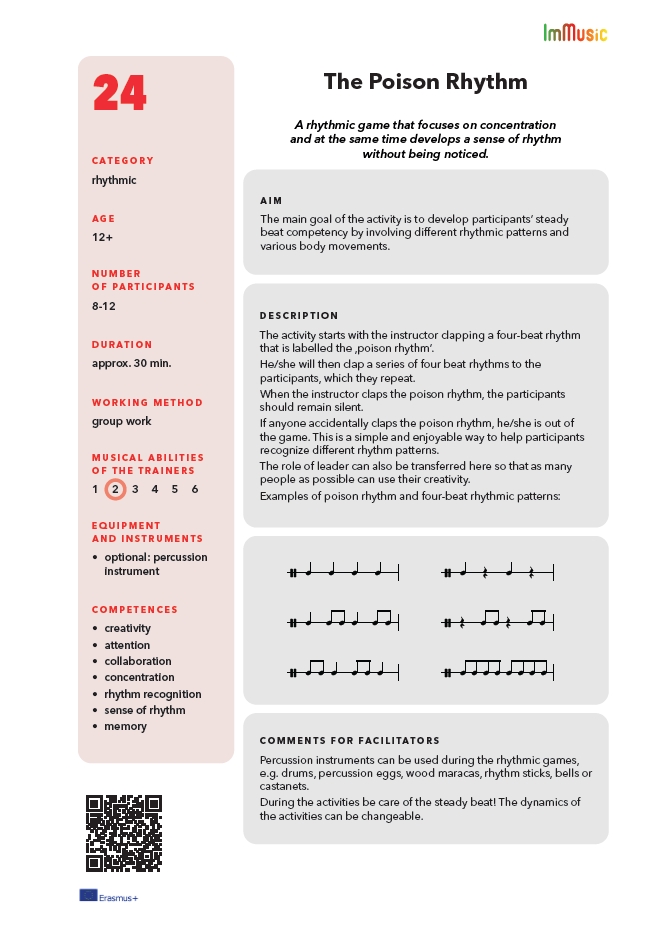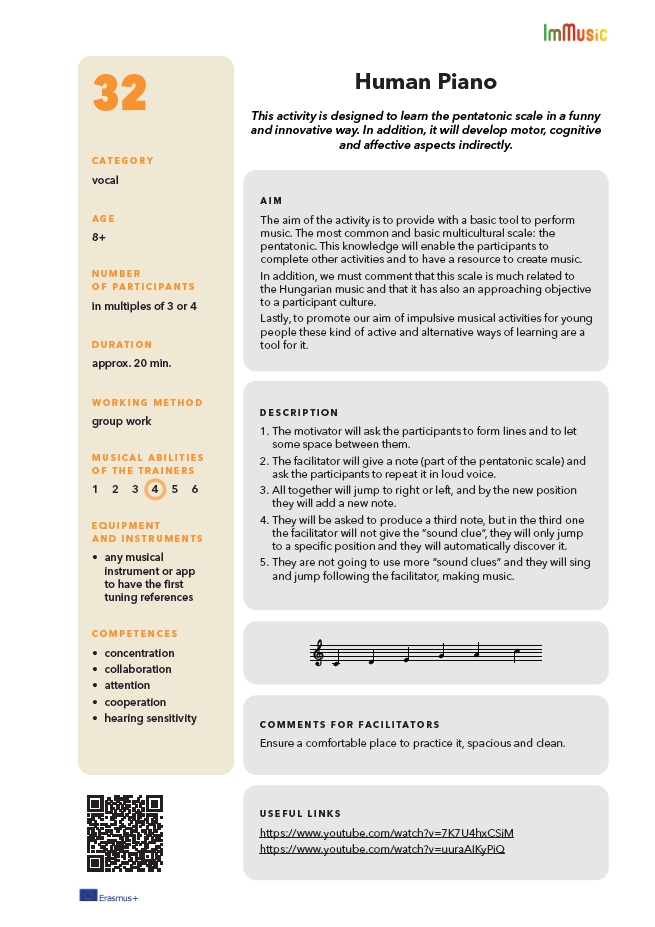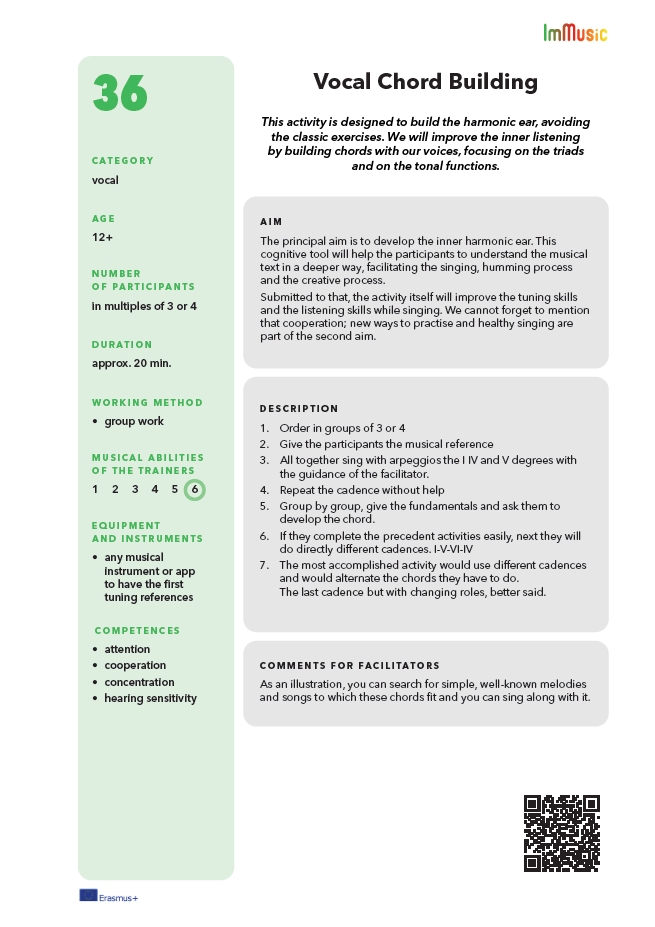ImMusic TOOLKIT
Let the Games Begin!
Free youth music activities for competence development
We’re proud to share the ImMusic Toolkit, a free publication filled with creative music games designed for youth professionals, educators, and community leaders.
Whether you’re working with a choir, youth club, classroom, or intercultural group, the toolkit offers flexible, easy-to-lead activities that help build musical sensitivity, social connection, and youth competences through play.
What’s inside?
Preface – the story behind the project
Competence guide – what skills each activity supports
Rhythms – essential pulse patterns that bring the music games to life
Scores – core musical material used in the games
Games – adaptable for various ages and settings
Imprint & contributors
Let’s dive in
Preface
Impulsive Music Activities to Promote Intercultural Relations
We are pleased to announce to interested youth professionals the toolkit prepared in the framework of the ImMusic project to enrich the range of programs of youth communities. The toolkit gives the opportunity for flexible, enjoyable and easily learn musical exercises, through which not only musical sensitivity but other – personal, social and communicative – competences can be improved.
As part of the ImMusic – Impulsive Music Activities to Promote Intercultural Relations project, dozens of musical tutorials were prepared, which provide the opportunity to hold special music sessions in a youth environment. Among them, there are quite simple ones that can function as a few minutes of relaxation, but there are more serious ones that require more preparation on the part of youth workers and animators and can even be recurring elements in the program of a training or a youth camp. During the exercises, the participants primarily use their own voice and body (singing, clapping, tapping, clicking, rhythmic walking, etc.), but they can use simple tools, primarily as percussion instruments. The tasks are available individually and as a whole on the project website and in the printed publication. The collection of exercises is primarily intended to enrich the work of youth workers and professionals dealing with youth, but also enriches the practice of amateur music ensembles. One of the most important benefits of the project is that the participating musicians and youth professionals were able to get to know each other and mutually evaluate each other’s activities.
Musical games can enhance cognitive, affective and motoric skills, i.e. rhythmic and melodic skills, cooperative, or spatial-orientational skills. Singing itself requires concentration, listening perception, memory, and fine motor skills. Besides developing their skills with these musical activities, participants can have a great time experiencing a flow state.
Every culture has some form of music with a steady beat, a perceived periodic pulse, which is one of the most fundamental concepts in music. The ongoing, steady, repetitive pulse that occurs in songs, chants and rhymes, is also connected with fluency in reading and it enhances communication skills. Furthermore, children with better skills in steady beat are reported to be better behaved and have less aggressive physical contact with other students. One of the goals of these enjoyable and beneficial rhythm activities is to develop participants’ steady beat competency by involving different rhythmic patterns and various body movements.
During the activities participants use a form of improvisation, i.e. a performance of art that develops a broad range of musical and non-musical skills. Besides the cognitive (i.e. memory) and physiological (i.e. motor skills) areas, they widen their musical repertoire, improve their perceptual strategies, problem- solving routines, and fine and gross motor skills. These creative activities allow students to create rhythms spontaneously, movements and new forms as well as new texts to adhere to the basic rhythms.
They may also improvise a musical answer to the instructor’s musical questions. Improvisation activities can be extended by changing them into composition activities.
The main objectives of these music activities are to introduce participants to the joy of playing music together, as well to provide some knowledge of musical experience, understanding and enjoyment.
Partner organizations:
Hangkeltő Foundation
Foundation for Youth Awareness
World Music School Helsinki
Coyote Initiatives CIC
‘Microkosmos’ Associazione Culturale Italo-Ellenica per la Formazione
ImMusic games aren’t just playful – they’re powerful. Behind every clap, echo, rhythm, and group song is a carefully designed opportunity to build essential youth competences. From coordination to creativity, empathy to memory, these youth music activities help young people grow in ways that feel natural, inclusive, and deeply human. Explore how each skill connects to the games and how music becomes a pathway for learning, expression, and connection.
Competence guide
How ImMusic games help develop essential skills in youth
ATTENTION – Rhythmic tasks provide a structured beat that gently trains focus and reduces wandering attention.
BODY BALANCE – Movement‑based games, stepping and echo play build physical equilibrium and stability.
BREATHING TECHNIQUE – Vocal warm‑ups encourage controlled breathing which supports calmness and group singing.
COLLABORATION – Call‑and‑response or layered rhythm games require listening and responding to peers.
COMMON SINGING – Group voices blend during simple songs, creating unity and mutual awareness.
CONCENTRATION – Music games support sustained attention through repetition and multi‑sensory cues.
COOPERATION – Shared rhythms or group patterns demand pacing with others and mutual support.
CREATIVITY – Improvised soundscapes, vocal play, and body percussion invite variations and new ideas.
CULTURAL SENSITIVITY – Diverse rhythm styles and games allow exploration of different musical traditions.
EMPATHY – Listening exercises help young people feel and mirror one another’s sound choices.
EXPRESSION – Sound games unleash emotional and physical expression beyond words.
GENERAL FITNESS – Body‑based rhythm and movement games boost coordination, stamina, and energy.
IMPROVISATION – Open‑ended games encourage spontaneous musical decisions and play.
LEARNING – Many games follow clear patterns and rules that support gradual skill development.
MEMORY – Call‑back patterns and rhythmic sequences help embed short-term and long-term recall.
MOVEMENT COORDINATION – Clapping, tapping and moving in sync refine motor pathways.
MUSICAL HEARING – Repetition of tones and rhythms sharpens pitch and timing awareness.
OPEN MINDEDNESS – Trying new sounds and collaborating with others cultivates curiosity and receptivity.
PERCEPTION – Rhythmic listening and echo drills heighten sensitivity to subtle timing differences.
QUICK REACTION – Fast turn-taking games train agility and rapid adaptation to sound cues.
RHYTHM RECOGNITION – Patterns embedded in exercises enhance the ability to feel and reproduce tempo.
SENSE OF RHYTHM – Consistent beat‑based group play strengthens inner timing and pulse accuracy.
TEAM COHESION – Shared rhythmic sequences promote unity, trust, and collective timing.
TEXT INTERPRETATION – Singing short texts or chants develops understanding of rhythm in language.
Why It Works
ImMusic’s music games engage the whole body and every sense – voice, movement, listening, and teamwork. As participants play, they are simultaneously challenged to listen deeply, express freely, and work as one. This playful, non-formal environment creates a low-pressure yet powerful space for young people to build self-confidence, social awareness, and artistic awareness – all while having fun.
In non-formal education, these competences support broader learning outcomes and help young people apply musical learning to everyday life and teamwork
The games in the ImMusic toolkit are carefully designed to be clear, flexible, and ready to use – whether you’re a youth worker, educator, or workshop facilitator. Each activity includes detailed instructions, clearly defined competences, recommended group size, age range, duration, and the equipment you may need (often minimal, sometimes just a metronome or your voice).
In addition to written guidance, many games include:
- Scores and lyrics to support musical learning
- YouTube links for demonstration and inspiration
- Facilitator tips to help you adapt each game to your group
Whether you’re looking for a quick energizer or a structured skill-building task, these games help young people connect, express, and grow – all through music and movement.
For young people, playing with rhythm strengthens not only coordination and focus, but also supports the development of pattern recognition, logic, and memory – essential skills for learning, communication, and everyday life.
Even those new to sheet music can explore, experiment, and learn by doing. Starting with the basics, participants can gradually discover how notes become music and how written patterns translate into shared sound. It’s not just reading – it’s listening with your eyes.
Realized within the framework of an Erasmus+ project, the imprint gives credit to the people and organizations who shaped the content, coordinated the project, edited the materials, and designed every beat, breath, and bar. It’s a behind-the-scenes look at the names, places, and efforts that made ImMusic a reality.
IMprint
The publication was realized as a result of the ERASMUS+ project 2019-1-HU01-KA205-060687 coordinated by Hangkeltő Foundation, Budapest, Hungary
The tutorials are elaborated by teh experts of the partner organizations:
Hangkeltő Foundation
Foundation for Youth Awareness
World Music School Helsinki
Coyote Initiatives CIC
‘Microkosmos’ Associazione Culturale Italo-Ellenica per la Formazione
The contents of this publication are the sole responsibility of the Hangkeltő Foundation and do not necessarily reflect the opinion of the European Union.
Publisher: Hangkeltő Foundation
Responsible: Csaba Tőri president
Edited by Edit Pálinkás
Design: DIVISART Ltd.
Press: Digitalpress
Budapest, Hungary 2022













